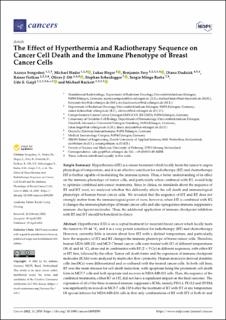Bitte benutzen Sie diese Kennung, um auf die Ressource zu verweisen:
https://doi.org/10.21256/zhaw-26893| Publikationstyp: | Beitrag in wissenschaftlicher Zeitschrift |
| Art der Begutachtung: | Peer review (Publikation) |
| Titel: | The effect of hyperthermia and radiotherapy sequence on cancer cell death and the immune phenotype of breast cancer cells |
| Autor/-in: | Sengedorj, Azzaya Hader, Michael Heger, Lukas Frey, Benjamin Dudziak, Diana Fietkau, Rainer Ott, Oliver J. Scheidegger, Stephan Mingo Barba, Sergio Gaipl, Udo S. Rückert, Michael |
| et. al: | No |
| DOI: | 10.3390/cancers14092050 10.21256/zhaw-26893 |
| Erschienen in: | Cancers |
| Band(Heft): | 14 |
| Heft: | 9 |
| Seite(n): | 2050 |
| Erscheinungsdatum: | 19-Apr-2022 |
| Verlag / Hrsg. Institution: | MDPI |
| ISSN: | 2072-6694 |
| Sprache: | Englisch |
| Schlagwörter: | Breast cancer; Dendritic cell activation; Hyperthermia; Hyperthermia treatment sequence; Immune checkpoint molecule; Immune phenotype; Radiotherapy |
| Fachgebiet (DDC): | 616: Innere Medizin und Krankheiten |
| Zusammenfassung: | Hyperthermia (HT) is an accepted treatment for recurrent breast cancer which locally heats the tumor to 39-44 °C, and it is a very potent sensitizer for radiotherapy (RT) and chemotherapy. However, currently little is known about how HT with a distinct temperature, and particularly, how the sequence of HT and RT changes the immune phenotype of breast cancer cells. Therefore, human MDA-MB-231 and MCF-7 breast cancer cells were treated with HT of different temperatures (39, 41 and 44 °C), alone and in combination with RT (2 × 5 Gy) in different sequences, with either RT or HT first, followed by the other. Tumor cell death forms and the expression of immune checkpoint molecules (ICMs) were analyzed by multicolor flow cytometry. Human monocyte-derived dendritic cells (moDCs) were differentiated and co-cultured with the treated cancer cells. In both cell lines, RT was the main stressor for cell death induction, with apoptosis being the prominent cell death form in MCF-7 cells and both apoptosis and necrosis in MDA-MB-231 cells. Here, the sequence of the combined treatments, either RT or HT, did not have a significant impact on the final outcome. The expression of all of the three examined immune suppressive ICMs, namely PD-L1, PD-L2 and HVEM, was significantly increased on MCF-7 cells 120 h after the treatment of RT with HT of any temperature. Of special interest for MDA-MB-231 cells is that only combinations of RT with HT of both 41 and 44 °C induced a significantly increased expression of PD-L2 at all examined time points (24, 48, 72, and 120 h). Generally, high dynamics of ICM expression can be observed after combined RT and HT treatments. There was no significant difference between the different sequences of treatments (either HT + RT or RT + HT) in case of the upregulation of ICMs. Furthermore, the co-culture of moDCs with tumor cells of any treatment had no impact on the expression of activation markers. We conclude that the sequence of HT and RT does not strongly affect the immune phenotype of breast cancer cells. However, when HT is combined with RT, it results in an increased expression of distinct immune suppressive ICMs that should be considered by including immune checkpoint inhibitors in multimodal tumor treatments with RT and HT. Further, combined RT and HT affects the immune system in the effector phase rather than in the priming phase. |
| URI: | https://digitalcollection.zhaw.ch/handle/11475/26893 |
| Volltext Version: | Publizierte Version |
| Lizenz (gemäss Verlagsvertrag): | CC BY 4.0: Namensnennung 4.0 International |
| Departement: | School of Engineering |
| Organisationseinheit: | Institut für Angewandte Mathematik und Physik (IAMP) |
| Publiziert im Rahmen des ZHAW-Projekts: | Hyperboost |
| Enthalten in den Sammlungen: | Publikationen School of Engineering |
Dateien zu dieser Ressource:
| Datei | Beschreibung | Größe | Format | |
|---|---|---|---|---|
| 2022_Sengedorj-etal_Hyperthermia-radiotherapy-sequence-effect-cancer-cell-death.pdf | 4.78 MB | Adobe PDF |  Öffnen/Anzeigen |
Zur Langanzeige
Sengedorj, A., Hader, M., Heger, L., Frey, B., Dudziak, D., Fietkau, R., Ott, O. J., Scheidegger, S., Mingo Barba, S., Gaipl, U. S., & Rückert, M. (2022). The effect of hyperthermia and radiotherapy sequence on cancer cell death and the immune phenotype of breast cancer cells. Cancers, 14(9), 2050. https://doi.org/10.3390/cancers14092050
Sengedorj, A. et al. (2022) ‘The effect of hyperthermia and radiotherapy sequence on cancer cell death and the immune phenotype of breast cancer cells’, Cancers, 14(9), p. 2050. Available at: https://doi.org/10.3390/cancers14092050.
A. Sengedorj et al., “The effect of hyperthermia and radiotherapy sequence on cancer cell death and the immune phenotype of breast cancer cells,” Cancers, vol. 14, no. 9, p. 2050, Apr. 2022, doi: 10.3390/cancers14092050.
SENGEDORJ, Azzaya, Michael HADER, Lukas HEGER, Benjamin FREY, Diana DUDZIAK, Rainer FIETKAU, Oliver J. OTT, Stephan SCHEIDEGGER, Sergio MINGO BARBA, Udo S. GAIPL und Michael RÜCKERT, 2022. The effect of hyperthermia and radiotherapy sequence on cancer cell death and the immune phenotype of breast cancer cells. Cancers. 19 April 2022. Bd. 14, Nr. 9, S. 2050. DOI 10.3390/cancers14092050
Sengedorj, Azzaya, Michael Hader, Lukas Heger, Benjamin Frey, Diana Dudziak, Rainer Fietkau, Oliver J. Ott, et al. 2022. “The Effect of Hyperthermia and Radiotherapy Sequence on Cancer Cell Death and the Immune Phenotype of Breast Cancer Cells.” Cancers 14 (9): 2050. https://doi.org/10.3390/cancers14092050.
Sengedorj, Azzaya, et al. “The Effect of Hyperthermia and Radiotherapy Sequence on Cancer Cell Death and the Immune Phenotype of Breast Cancer Cells.” Cancers, vol. 14, no. 9, Apr. 2022, p. 2050, https://doi.org/10.3390/cancers14092050.
Alle Ressourcen in diesem Repository sind urheberrechtlich geschützt, soweit nicht anderweitig angezeigt.